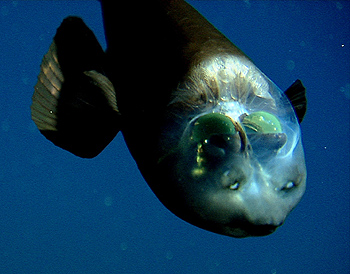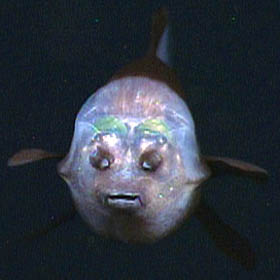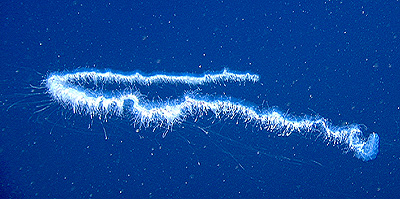Monterey Bay Aquarium Research Institute researchers recently unraveled a 50-year-old mystery surrounding a fish with tubular eyes and a transparent head, known as the “barreleye” fish (Macropinna microstoma). Originally thought to have fixed eyes, a new study by Bruce Robison and Kim Reisenbichler reveals that these eyes can rotate within a transparent shield, providing the fish with a versatile view for hunting and feeding.
Deep-sea fish have adapted to their pitch-black environment in a variety of amazing ways. Several species of deep-water fishes in the family Opisthoproctidae are called “barreleyes” because their eyes are tubular in shape. Barreleyes typically live near the depth where sunlight from the surface fades to complete blackness. They use their ultra-sensitive tubular eyes to search for the faint silhouettes of prey overhead.

While tubular eyes excel at collecting light, they traditionally offer a limited field of view. Until recently, marine biologists believed that the barreleye’s eyes were fixed upward, making it challenging for them to see in front or capture prey. Bruce Robison and Kim Reisenbichler, utilizing video footage from MBARI’s remotely operated vehicles (ROVs), discovered a new aspect of these fish. At depths of 600 to 800 meters, the ROV footage unveiled barreleyes with eyes surrounded by a transparent, fluid-filled shield atop their heads, challenging prior assumptions.

This front view of a barreleye, illuminated by MBARI’s remotely operated vehicle Tiburon, showcases its transparent shield. Traditional descriptions often omit this feature, damaged during net retrieval from the deep. Luckily, researchers Robison and Reisenbichler observed a live barreleye in a ship-board aquarium, confirming its ability to rotate tubular eyes when changing positions. They propose that the fish, usually motionless with eyes upward, filters sunlight with green pigments to spot bioluminescent prey overhead. When it identifies a target, like a drifting jelly, the barreleye rotates its eyes forward and ascends for feeding.

Barreleyes coexist in the deep sea with various jellyfish, including the Apolemia siphonophores that can grow over 10 meters long. These colonial jellies trail stinging tentacles, capturing small animals like copepods. Researchers believe barreleyes may navigate among these tentacles, using their rotating eyes to spot and pick off captured organisms, while their transparent shields protect them from stinging cells.
Bruce Robison and Kim Reisenbichler aim to explore if their findings about Macropinna microstoma apply to other deep-sea fish with tubular eyes. The unique adaptations of barreleyes, long a mystery to oceanographers, are becoming clearer through observations with modern underwater robots.